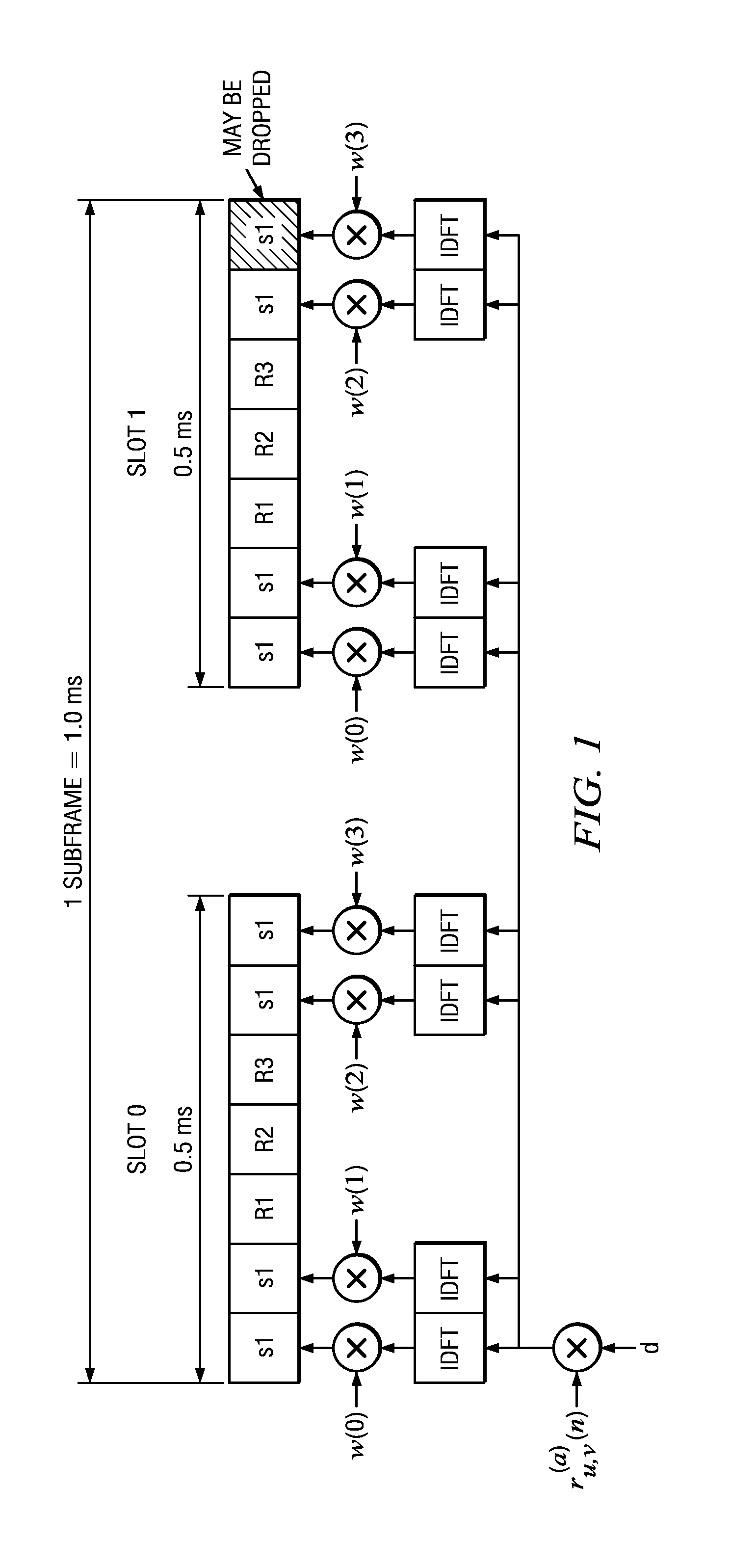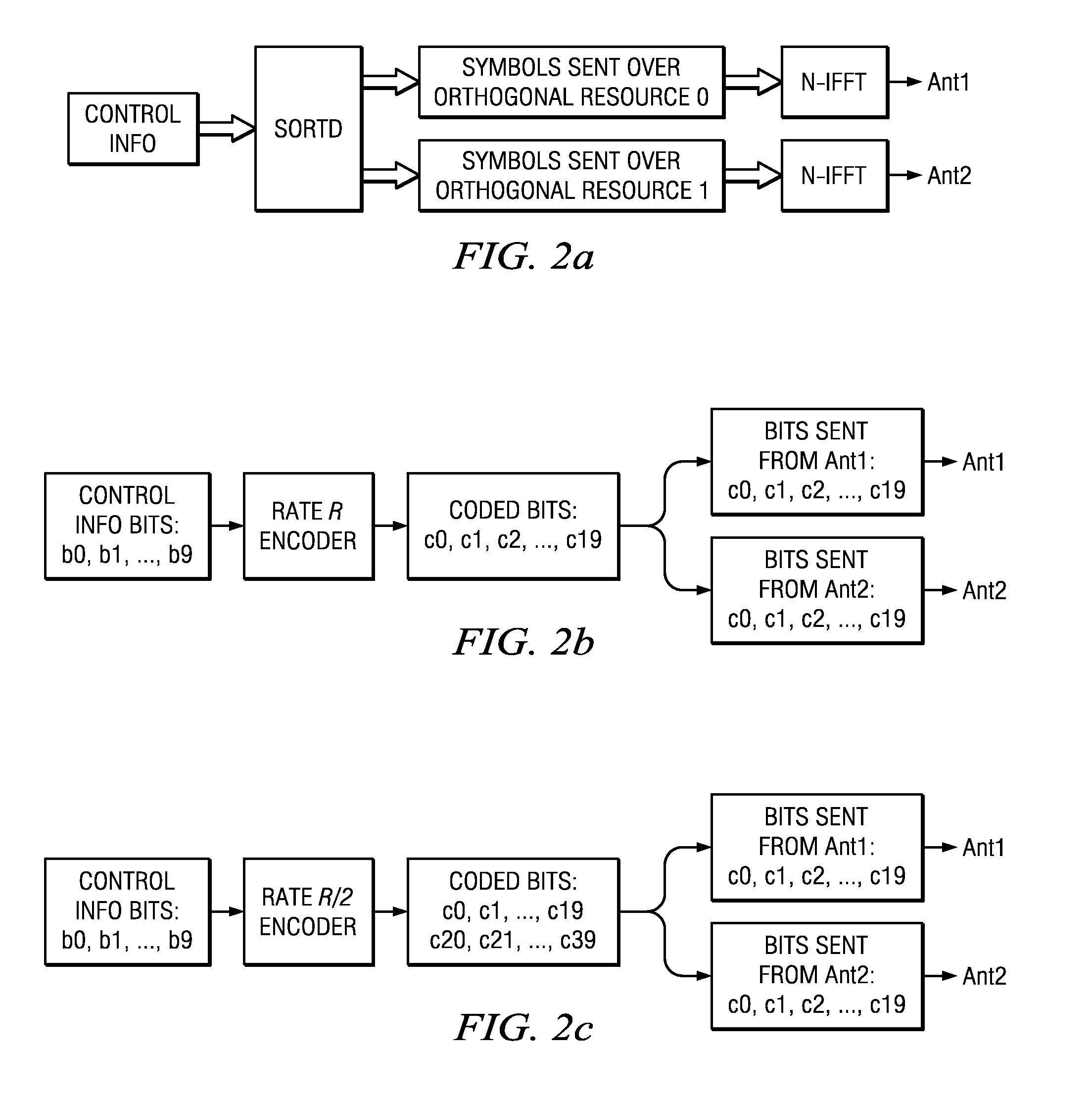Orthogonal Resource Selection Transmit Diversity
a technology of transmit diversity and orthogonal resources, applied in the field of telecommunications, can solve the problems of channel selection, channel should not be used, and the number of orthogonal resources used for 1 antenna transmission is twice the number of times,
- Summary
- Abstract
- Description
- Claims
- Application Information
AI Technical Summary
Benefits of technology
Problems solved by technology
Method used
Image
Examples
embodiment # 1
Alternative Embodiment #1
[0102]
TABLE 4Alternative STRSD Code #1Codewords 0 to 15Ant.SlotRResDRes000000010010001101000101011001111100110111101111100010011010101100001j−j−10000000000000100001j−j−10000000002000000001j−j−10000030000000000001j−j−11001j−j−10000000000000100001j−j−10000000002000000001j−j−10000030000000000001j−j−11010000000000000−jj1−111−jj1−1000000000000120000−jj1−1000000001300000000−jj1−10000110000000000000−jj1−111−jj1−1000000000000120000−jj1−1000000001300000000−jj1−10000
[0103]The code shown in Table 4 has the following main properties:[0104]1) The orthogonal resources used for RS are fixed for each transmit antenna. This may mean less complexity in encoding in the transmitter.[0105]2) The modulation symbols do not vary across slots. Indeed, for each transmit antenna, only one modulation symbol is transmitted at both slots.
embodiment # 2
Alternative Embodiment #2
[0106]
TABLE 5Alternative STRSD Code #2Codewords 0 to 15Ant.SlotRResDRes000000010010001101000101011001111100110111101111100010011010101100001j−j−10000000000000100001j−j−10000000002000000001j−j−10000030000000000001j−j−11001j−j−10000000000000100001j−j−10000000002000000001j−j−10000030000000000001j−j−11010000000000000−jj1−111−jj1−1000000000000120000−jj1−1000000001300000000−jj1−10000110000000000000−j1j−111−j1j−1000000000000120000−j1j−1000000001300000000−j1j−10000
[0107]The code shown in Table 5 is obtained from Table 4 by allowing the second slot of the second antenna to use a different QPSK symbol compared to the first slot. By applying this change the performance is improved. The first antenna still has commonality with PUCCH formats 1a / 1b single antenna transmission in LTE Rel-8. The performance can be further improved by also changing the symbols on the second slot of the first antenna.
[0108]Component #3: Variable Rate Operation
embodiment # 3
Alternative Embodiment #3
[0109]
TABLE 6Alternative STRSD Code #3Codewords 0 to 15Ant.SlotRResDRes000000010010001101000101011001111100110111101111100010011010101100001j−j−10000000000002100001j−j−10000000002000000001j−j−10000230000000000001j−j−11001j−j−10000000000002100001j−j−10000000002000000001j−j−10000230000000000001j−j−11030000000000000−jj1−111−jj1−1000000000000120000−jj1−1000000003300000000−jj1−10000130000000000000−j1j−111−j1J−1000000000000120000−j1j−1000000003300000000−j1j−10000
[0110]The code shown in Table 6 has a ‘nested property’. The table shows a 16-state code, corresponding to a 4 bit Ack / Nack transmission scenario. However, if only 2 or 3 Ack / Nack bits are to be transmitted, then a subcode with 4 or 8 codewords, respectively, can be chosen such that only 2 or 3 resources are used for transmission. In general, we use a code mapping wherein 2N states of the code corresponding to N information bits utilize at most N orthogonal resources.
[0111]It is important to note that not ...
PUM
 Login to View More
Login to View More Abstract
Description
Claims
Application Information
 Login to View More
Login to View More - R&D
- Intellectual Property
- Life Sciences
- Materials
- Tech Scout
- Unparalleled Data Quality
- Higher Quality Content
- 60% Fewer Hallucinations
Browse by: Latest US Patents, China's latest patents, Technical Efficacy Thesaurus, Application Domain, Technology Topic, Popular Technical Reports.
© 2025 PatSnap. All rights reserved.Legal|Privacy policy|Modern Slavery Act Transparency Statement|Sitemap|About US| Contact US: help@patsnap.com



